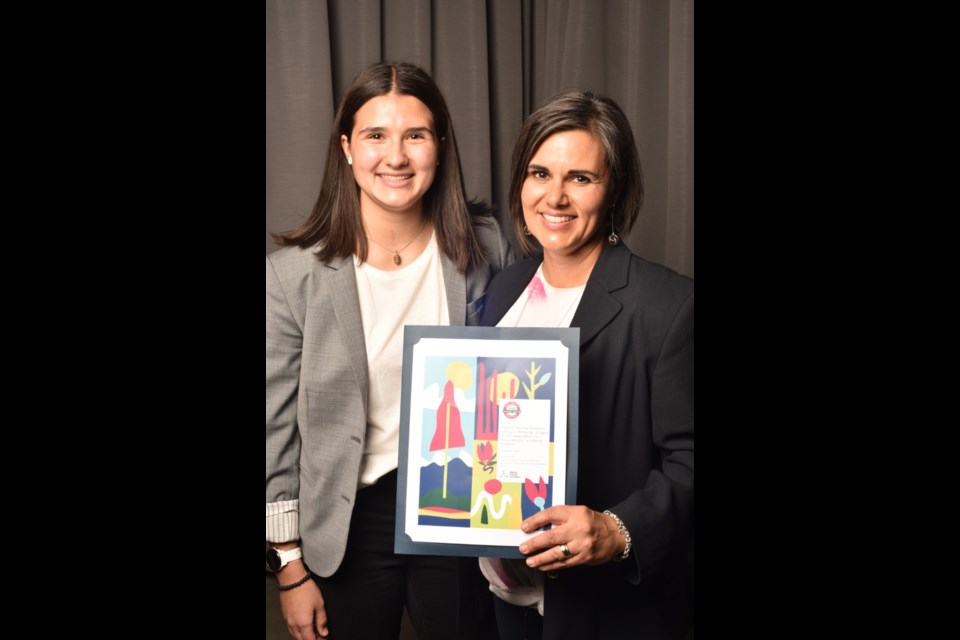A Cochrane-based non-profit has been recognized for its efforts in helping plot the course to an environmentally sustainable future for successive generations of Albertans.
Alberta Tomorrow, a free, online interactive planning tool and app that illustrates the ecological footprint of humans throughout the province, received an Emerald Award in the education category at the Alberta Emerald Foundation’s 31st annual awards ceremony in Calgary earlier this month.
“It’s all about understanding that we impact the environment when we use it and also understanding that we need these things in the environment,” explained Jennifer Janzen, a former biologist and the non-profit’s executive director. “It’s about finding that balance of how do we access our natural resources in a way that is best for the environment and therefore best for us.”
The apple doesn’t fall far from the tree in the Janzen family. The executive director’s daughter, Jade, scooped up an Emerald Award in the youth category last year for her own initiative, Lives with Less Plastic.
Not unlike Lives with Less Plastic, Alberta Tomorrow has an education-first mandate. Founded by landscape ecologist Dr. Brad Stelfox and ecologist Matthew Carlson in 2003, the non-profit’s mission is to deliver a platform that empowers people to design and sustain a future for the ecosystem of the province. The planning simulator is designed for students, teachers, and anyone interested in the future landscape of Alberta.
The online tool illustrates how the land has changed in each watershed throughout the province from 1910 to now, using satellite imagery and Geographic Information Systems (GIS) data obtained through a tool called ALCES Online, which Stelfox also built.
“[It] can also project 30 years into the future what might happen if we just keep doing things the way we have been doing them,” said Janzen.
As the land changes, the simulator shows how water, air quality, and wildlife habitats are affected via a map overlay of wetlands, grasslands, forests, open water, cities, towns, and agricultural areas displayed in different colours.
It also shows how socio-economic indicators such as GDP, human population growth, oil and gas, timber, and agricultural production change along with the environment in a set of corresponding dials next to the map. Using built-in equations, the tool calculates what would happen to water quality, natural landscapes, greenhouse gas emissions, and so on, with or without human intervention.
“I think the power of Alberta Tomorrow is it allows you to actually visualize the change instead of just talking about the change that has either taken place or may take place in the future,” said Janzen.
Since the non-profit launched its namesake planning simulator, Alberta Tomorrow has garnered more than 18,000 registered users. The platform is primarily used by students in grades 4 through 11 based on curriculum connections, but it’s also used by post-secondary institutions and other non-profits.
“I think the biggest learning that students get from using it is that we have a finite landscape here in Alberta,” said Janzen. “We have only so much space and we can’t do everything, everywhere all the time – we have to make some decisions of what we’re going to use this portion of land for and how much we’re going to preserve.”
It’s a difficult crossroads to come to, Janzen added, but it’s one that can’t be avoided.
“We have to make some really tough decisions on what we’re doing on the land today, in order to get the future that we want. There’s going to be a lot of trade-offs,” she said. “If Cochrane keeps growing the way it has been and everybody wants to live in huge homes and have huge yards, that’s going to take up a lot of space.
“That means that the land surrounding Cochrane will no longer be agricultural or native grassland or wetland areas … it’s a tough pill to swallow, because I think as Albertans, we feel like we have a lot of space and like we can do anything, anywhere.”
Alberta Tomorrow was a finalist for an Emerald Award in 2019 and again in 2021. To win the award after nearly 20 years of operations means a lot, said Janzen, who has been with the non-profit since 2007.
“We’re a pretty small shop,” she said. “I work part-time, we have a computer programmer who’s part-time, and then we have a board of directors that are purely volunteers.
“It meant a lot to win this because there’s been a lot of hard work and effort over the years.”
Alberta Tomorrow’s future plans involve the addition of an Indigenous module for the simulator, which will include province-wide maps of traditional territories, treaty areas, reserve locations, and former residential school sites.
They are currently working with students at Siksika High School to come up with a plan to use the traditional Blackfoot territory as a study area as opposed to the Bow River Basin.
“We’re looking at what indicators are really culturally relevant to the Blackfoot people of that area,” said Janzen. “Right now, we’ve got grizzly bear habitat on there, but maybe there was a specific species of fish that used to be more abundant in the river that they were dependent on but no longer exists, for example.”
The non-profit is looking at expanding more across Canada and already has a B.C. Tomorrow simulator deployed and running in B.C. schools. They’ve recently launched a Canada Tomorrow website with the vision of developing customized educational land-use simulators that account for regional differences across the country.
To learn more or register for an Alberta Tomorrow account, visit albertatomorrow.ca.


